
Concept explainers
(a)
Interpretation:
The solubility of malic acid in water needs to be explained.
Concept Introduction:
Organic compounds are mainly composed of C and H atoms. It is the branch of chemistry that deals with preparation, reactions, and properties of organic compounds. The atom or group of atoms which are responsible for all special chemical and physical properties of a substance is called as a
Organic compounds are mainly covalent compounds in which C-C, C-H and C-X bonds are present. Here 'X' indicates hetero atom which is present in functional group. The C-C and C-H bonds are non-polar covalent bonds as the difference between the electronegativity of C and H is very less. On the contrary the polarity of C-X bond depends on the electronegativity of X. If X is O, N or halogen, the C-X bond will be a polar covalent bond that makes the polar organic molecule.
Answer to Problem 1Q
Malic acid is soluble in water.
Explanation of Solution
A polar covalent molecule will be soluble in water whereas a non-polar covalent compound will be insoluble in water based on the concept of "Like dissolves like". Some of the polar compounds are also not soluble in water as they cannot form hydrogen bonding with water molecules.
The structure of malic acid is as follows:
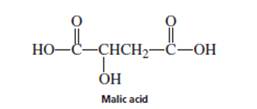
Malic acid is a polar molecule due to the presence of two -COOH group in the molecule. Hence, it is soluble in water as it can form Hydrogen-bond with water molecule.
(b)
Interpretation:
The solubility of naphthalene in water needs to be explained.
Concept Introduction:
Organic compounds are mainly composed of C and H atoms. It is the branch of chemistry that deals with preparation, reactions, and properties of organic compounds. The atom or group of atoms which are responsible for all special chemical and physical properties of a substance is called as a functional group. These groups are bonded to the parent carbon chain of the organic molecule.
Organic compounds are mainly covalent compounds in which C-C, C-H and C-X bonds are present. Here 'X' indicates hetero atom which is present in functional group. The C-C and C-H bonds are non-polar covalent bonds as the difference between the electronegativity of C and H is very less. On the contrary the polarity of C-X bond depends on the electronegativity of X. If X is O, N or halogen, the C-X bond will be a polar covalent bond that makes the polar organic molecule.
Answer to Problem 1Q
Naphthalene is insoluble water.
Explanation of Solution
The structure of naphthalene is as follows:
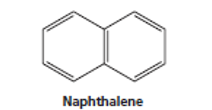
Naphthalene is a non-polar molecule as it is only composed C and H with two ring structures. Hence it is insoluble in water as it cannot form Hydrogen-bond with water molecule.
(c)
Interpretation:
The solubility of amphetamine in ethyl alcohol needs to be determined.
Concept Introduction:
Organic compounds are mainly composed of C and H atoms. It is the branch of chemistry that deals with preparation, reactions, and properties of organic compounds. The atom or group of atoms which are responsible for all special chemical and physical properties of a substance is called as a functional group. These groups are bonded to the parent carbon chain of the organic molecule.
Organic compounds are mainly covalent compounds in which C-C, C-H and C-X bonds are present. Here 'X' indicates hetero atom which is present in functional group. The C-C and C-H bonds are non-polar covalent bonds as the difference between the electronegativity of C and H is very less. On the contrary the polarity of C-X bond depends on the electronegativity of X. If X is O, N or halogen, the C-X bond will be a polar covalent bond that makes the polar organic molecule.
Answer to Problem 1Q
Amphetamine is soluble in ethyl alcohol.
Explanation of Solution
The structure of amphetamine is as follows:
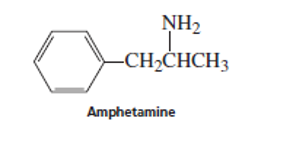
Amphetamine is a polar molecule as it contains one −NH2group and it can form hydrogen bond with water and ethanol. Hence, it is soluble in ethanol.
(d)
Interpretation:
The solubility of Aspirin in water needs to be explained.
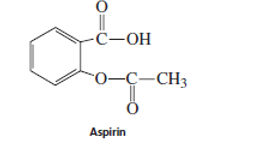
Concept Introduction:
Organic compounds are mainly composed of C and H atoms. It is the branch of chemistry that deals with preparation, reactions, and properties of organic compounds. The atom or group of atoms which are responsible for all special chemical and physical properties of a substance is called as a functional group. These groups are bonded to the parent carbon chain of the organic molecule.
Organic compounds are mainly covalent compounds in which C-C, C-H and C-X bonds are present. Here 'X' indicates heteroatom which is present in functional group. The C-C and C-H bonds are non-polar covalent bonds as the difference between the electronegativity of C and H is very less. On the contrary the polarity of C-X bond depends on the electronegativity of X. If X is O, N or halogen, the C-X bond will be a polar covalent bond that makes the polar organic molecule.
Answer to Problem 1Q
Aspirin is slightly soluble in water.
Explanation of Solution
The structure of aspirin is as follows:
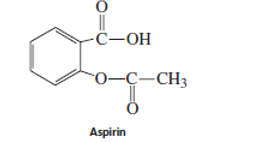
Aspirin is slightly soluble in water. Aspirin is a polar molecule as it contains one −COOHgroup and it can form hydrogen bond with water,yet the solubility is quite less due to bulky size of molecule.
(e)
Interpretation:
The solubility of succinic in hexane needs to be explained.
Concept Introduction:
Organic compounds are mainly composed of C and H atoms. It is the branch of chemistry that deals with preparation, reactions, and properties of organic compounds. The atom or group of atoms which are responsible for all special chemical and physical properties of a substance is called as a functional group. These groups are bonded to the parent carbon chain of the organic molecule.
Organic compounds are mainly covalent compounds in which C-C, C-H and C-X bonds are present. Here 'X' indicates heteroatom which is present in functional group. The C-C and C-H bonds are non-polar covalent bonds as the difference between the electronegativity of C and H is very less. On the contrary the polarity of C-X bond depends on the electronegativity of X. If X is O, N or halogen, the C-X bond will be a polar covalent bond that makes the polar organic molecule.
Answer to Problem 1Q
Succinic acid is insoluble in hexane.
Explanation of Solution
The structure of succinic acid is as follows:

Succinic acid is a polar molecule as it contains two −COOHgroups. Due to polar nature of molecule, it is soluble in water but insoluble in organic solvents like hexane.
(f)
Interpretation:
The solubility of ibuprofen in diethyl ether needs to be explained.
Concept Introduction:
Organic compounds are mainly composed of C and H atoms. It is the branch of chemistry that deals with preparation, reactions, and properties of organic compounds. The atom or group of atoms which are responsible for all special chemical and physical properties of a substance is called as a functional group. These groups are bonded to the parent carbon chain of the organic molecule.
Organic compounds are mainly covalent compounds in which C-C, C-H and C-X bonds are present. Here 'X' indicates heteroatom which is present in functional group. The C-C and C-H bonds are non-polar covalent bonds as the difference between the electronegativity of C and H is very less. On the contrary the polarity of C-X bond depends on the electronegativity of X. If X is O, N or halogen, the C-X bond will be a polar covalent bond that makes the polar organic molecule.
Answer to Problem 1Q
Ibuprofen is soluble in diethyl ether.
Explanation of Solution
The structure of ibuprofen is as follows:

Although ibuprofen contains one polar −COOH group yet due to bulky structure, it is overall non-polar molecule and can dissolve in organic solvents such as ether, benzene etc.
(g)
Interpretation:
The solubility of 1-decanol in water needs to be explained.
Concept Introduction:
Organic compounds are mainly composed of C and H atoms. It is the branch of chemistry that deals with preparation, reactions, and properties of organic compounds. The atom or group of atoms which are responsible for all special chemical and physical properties of a substance is called as a functional group. These groups are bonded to the parent carbon chain of the organic molecule.
Organic compounds are mainly covalent compounds in which C-C, C-H and C-X bonds are present. Here 'X' indicates heteroatom which is present in functional group. The C-C and C-H bonds are non-polar covalent bonds as the difference between the electronegativity of C and H is very less. On the contrary the polarity of C-X bond depends on the electronegativity of X. If X is O, N or halogen, the C-X bond will be a polar covalent bond that makes the polar organic molecule.
Answer to Problem 1Q
1-decanol is insoluble in water.
Explanation of Solution
The molecular formula of 1-decanol is as follows:
1-decanol is a polar compound with −OH group yet it is insoluble in water due to lack of hydrogen bonds between 1-decanol and water molecules. This is because of long hydrophobic C chain of 1-decanol molecule that prevents the formation of hydrogen bonding.
Want to see more full solutions like this?
Chapter 1 Solutions
A Small Scale Approach to Organic Laboratory Techniques
- For each reaction below, decide if the first stable organic product that forms in solution will create a new CC bond, and check the appropriate box. Next, for each reaction to which you answered "Yes" to in the table, draw this product in the drawing area below. Note for advanced students: for this problem, don't worry if you think this product will continue to react under the current conditions - just focus on the first stable product you expect to form in solution. དྲ。 ✗MgBr ? O CI Will the first product that forms in this reaction create a new C-C bond? Yes No • ? Will the first product that forms in this reaction create a new CC bond? Yes No × : ☐ Xarrow_forwardPredict the major products of this organic reaction: OH NaBH4 H ? CH3OH Note: be sure you use dash and wedge bonds when necessary, for example to distinguish between major products with different stereochemistry. Click and drag to start drawing a structure. ☐ : Sarrow_forwardPredict the major products of this organic reaction: 1. LIAIHA 2. H₂O ? Note: be sure you use dash and wedge bonds when necessary, for example to distinguish between major products with different stereochemistry. Click and drag to start drawing a structure. X : ☐arrow_forward
- For each reaction below, decide if the first stable organic product that forms in solution will create a new C - C bond, and check the appropriate box. Next, for each reaction to which you answered "Yes" to in the table, draw this product in the drawing area below. Note for advanced students: for this problem, don't worry if you think this product will continue to react under the current conditions - just focus on the first stable product you expect to form in solution. NH2 tu ? ? OH Will the first product that forms in this reaction create a new CC bond? Yes No Will the first product that forms in this reaction create a new CC bond? Yes No C $ ©arrow_forwardAs the lead product manager at OrganometALEKS Industries, you are trying to decide if the following reaction will make a molecule with a new C-C bond as its major product: 1. MgCl ? 2. H₂O* If this reaction will work, draw the major organic product or products you would expect in the drawing area below. If there's more than one major product, you can draw them in any arrangement you like. Be sure you use wedge and dash bonds if necessary, for example to distinguish between major products with different stereochemistry. If the major products of this reaction won't have a new CC bond, just check the box under the drawing area and leave it blank. Click and drag to start drawing a structure. This reaction will not make a product with a new CC bond. G marrow_forwardIncluding activity coefficients, find [Hg22+] in saturated Hg2Br2 in 0.00100 M NH4 Ksp Hg2Br2 = 5.6×10-23.arrow_forward
- give example for the following(by equation) a. Converting a water insoluble compound to a soluble one. b. Diazotization reaction form diazonium salt c. coupling reaction of a diazonium salt d. indacator properties of MO e. Diazotization ( diazonium salt of bromobenzene)arrow_forward2-Propanone and ethyllithium are mixed and subsequently acid hydrolyzed. Draw and name the structures of the products.arrow_forward(Methanesulfinyl)methane is reacted with NaH, and then with acetophenone. Draw and name the structures of the products.arrow_forward
- 3-Oxo-butanenitrile and (E)-2-butenal are mixed with sodium ethoxide in ethanol. Draw and name the structures of the products.arrow_forwardWhat is the reason of the following(use equations if possible) a.) In MO preperation through diazotization: Addition of sodium nitrite in acidfied solution in order to form diazonium salt b.) in MO experiment: addition of sodium hydroxide solution in the last step to isolate the product MO. What is the color of MO at low pH c.) In MO experiment: addition of sodium hydroxide solution in the last step to isolate the product MO. What is the color of MO at pH 4.5 d.) Avoiding not cooling down the reaction mixture when preparing the diazonium salt e.) Cbvcarrow_forwardA 0.552-g sample of an unknown acid was dissolved in water to a total volume of 20.0 mL. This sample was titrated with 0.1103 M KOH. The equivalence point occurred at 29.42 mL base added. The pH of the solution at 10.0 mL base added was 3.72. Determine the molar mass of the acid. Determine the Ka of the acid.arrow_forward
 EBK A SMALL SCALE APPROACH TO ORGANIC LChemistryISBN:9781305446021Author:LampmanPublisher:CENGAGE LEARNING - CONSIGNMENT
EBK A SMALL SCALE APPROACH TO ORGANIC LChemistryISBN:9781305446021Author:LampmanPublisher:CENGAGE LEARNING - CONSIGNMENT Introductory Chemistry: An Active Learning Approa...ChemistryISBN:9781305079250Author:Mark S. Cracolice, Ed PetersPublisher:Cengage Learning
Introductory Chemistry: An Active Learning Approa...ChemistryISBN:9781305079250Author:Mark S. Cracolice, Ed PetersPublisher:Cengage Learning General, Organic, and Biological ChemistryChemistryISBN:9781285853918Author:H. Stephen StokerPublisher:Cengage Learning
General, Organic, and Biological ChemistryChemistryISBN:9781285853918Author:H. Stephen StokerPublisher:Cengage Learning- Chemistry: Matter and ChangeChemistryISBN:9780078746376Author:Dinah Zike, Laurel Dingrando, Nicholas Hainen, Cheryl WistromPublisher:Glencoe/McGraw-Hill School Pub Co
 Chemistry: The Molecular ScienceChemistryISBN:9781285199047Author:John W. Moore, Conrad L. StanitskiPublisher:Cengage Learning
Chemistry: The Molecular ScienceChemistryISBN:9781285199047Author:John W. Moore, Conrad L. StanitskiPublisher:Cengage Learning Chemistry & Chemical ReactivityChemistryISBN:9781337399074Author:John C. Kotz, Paul M. Treichel, John Townsend, David TreichelPublisher:Cengage Learning
Chemistry & Chemical ReactivityChemistryISBN:9781337399074Author:John C. Kotz, Paul M. Treichel, John Townsend, David TreichelPublisher:Cengage Learning





